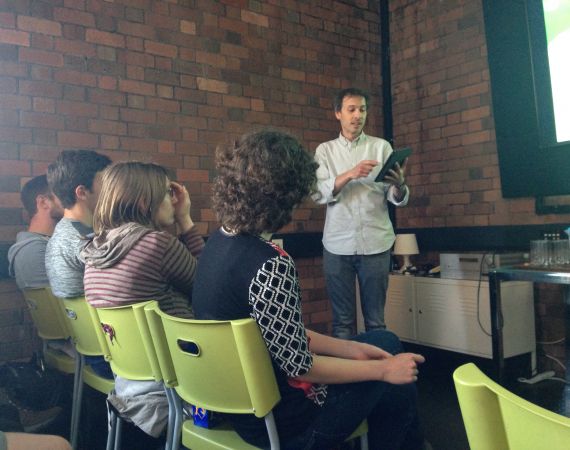Lunchtime talk write-up
Posted on Wed 15 Jun 2016
Informatics Lab: Useful and Beautiful Data
The Met Office Informatics Lab recently celebrated its first birthday. Its remit is to make environmental data useful and to challenge Met Office’s traditional internal structures.

Alberto Arribas
The Met Office Informatics Lab recently celebrated its first birthday. Its remit is to make environmental data useful and to challenge Met Office’s traditional internal structures. The Lab combines scientists, engineers, technologists and designers. Alberto Arribas, Jacob Tomlinson, Niall Robinson and Rachel Prudden joined us to share their working methods; ambitions and prototype projects, here are five things I learned:
1. The Informatics Lab develops concepts into fully working prototypes in short bursts. Using GitHub to open source their work, and a collaborative approach, the team is keen to develop larger public engagement projects. Working with the wider Met Office team, the Informatics Lab is interested in engaging the public to demonstrate their concepts, collect accurate data from everyone and to provide useful weather data that can impact on day-to-day living.
2. The Met Office generates 400TB of data every single day, moving that massive amount of data around the world is not an option. However, you do not need to move the data to make it useful! The key challenge is extracting the useful information from the big data. Working with forecasters at outposts across the world with varying levels of Internet connectivity the Informatics Lab is exploring how to arrange, compress, visualise and extract information in ways that can be useful to companies and individuals across the world.
3. “No one really cares about the weather”, what we do care about are the decisions we make on a day-to-day basis. What is the best time to go for a run? Should I have a BBQ this weekend? Do I need to wear a hat today? ‘A weather forecast you can talk to’ is a project Informatics Lab is developing using the Amazon Echo as an interface to assist people with decision-making. The user has to set their default preferences, such as their average run time, their location and their unique tolerances for different weather states. The Echo is then able to read the local weather forecast and integrate that with the user’s personal preferences to answer questions. The team would like to develop the software so it can include traffic data, personal calendars and other variables in the decision making process.
4. For all of the data collection and analysis that goes into each weather forecast, most people read the information through one symbol – but how do we individually interpret each symbol? Informatics Lab has developed an app intended to crowd source public opinion on the appropriate symbol, word, or picture for each weather state. In the future, ‘MySky’ could calibrate bespoke forecasts for individuals based on their taste and interpretation of the visualisation presented to them.
5. The weather and climate models created by The Met Office solve the physics equations that give rise to “entire versions of the atmosphere complete with clouds, rain, and wind”. The Informatics Lab has developed an application that allows you to get inside the model and view all these fields in a webpage, and it is also accessible on a tablet. ‘Fly through the model fields’ includes a video showing these applications, which allow forecasters in different countries to view the same data in real-time, as well as giving access to this level of information to the public in their homes.